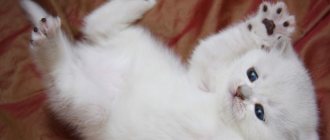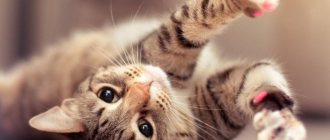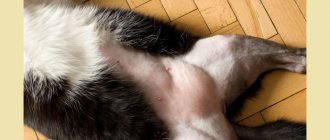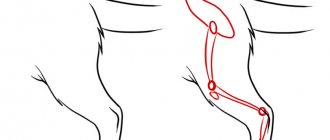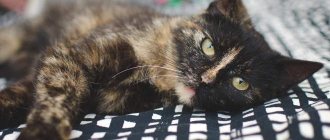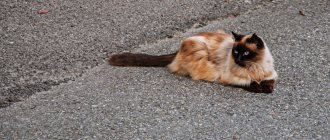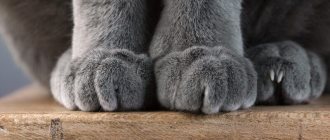Cats, like people, have their own body language. And because humans and cats, or any animal for that matter, cannot communicate with each other. There are also barriers to fully understanding their body language.
But with years of animal companionship, research, and observation, some cat mannerisms are now obvious and understandable—one of which we'll discuss in this post. Have you ever looked at your cat at random and noticed that it is twitching its paws?
Then you may wonder why they do this, why do cats twitch their paws? Read on to find out.
Causes of body trembling
The tremor effect is caused by strong muscle tension in the animal.
The cat may be stressed and scared. The desire to quietly get close to a sparrow sitting nearby causes muscle tension and a silent gait. But after capturing the desired victim, relaxation sets in, and characteristic muscle tremors are observed. During sleep
When the temperature drops, the cat may experience discomfort, a desire to stay warm, and shivering stimulates heat production. An uncomfortable position also causes shaking. Another source is the period of puberty, the rut. The cat is trembling from a powerful release of hormones, anticipating a quick meeting with the female. This condition is absolutely normal and no help is required.
If periodic trembling of the limbs is observed, you should pay close attention to the animal’s diet. Perhaps there is a banal weakness due to lack of nutrients, malnutrition
Small kittens may suffer from rickets, bowed legs, trembling becomes evidence of weak bones, weakened muscle tone.
When the cat shakes, unsuccessfully trying to return to the optimal position, you should start sounding the alarm. The condition is atypical, plus convulsions, vomiting, fever are mixed in - there is definitely some kind of disease. The most dangerous thing for a cat’s life is rhinotracheitis. A disease that affects the respiratory and visual systems can quickly lead to paralysis of the respiratory center and death of the animal.
If the cat is trembling all over, experiencing obvious difficulties in moving, or other signs of illness are observed, you should seek veterinary help. The veterinarian will examine the cat, assess its internal and external condition, and prescribe qualified treatment. In the other described cases, it is enough to provide the cat with additional heat, eliminate drafts, and balance the diet.
Why do cats and cats tremble?
Trembling is also called tremor, that is, they are synonyms. What is tremor in cats? These are rhythmic movements of the body or its individual parts (head, paws, tail) caused by muscle contraction.
Article continues after advertisement
Sometimes why a cat is trembling all over can become clear only after a detailed examination of the body. Therefore, if there are no visible reasons, this does not mean that they do not exist at all. For example, there may be an incubation (hidden) period of rabies: trembling is one of the first symptoms that cannot be ignored.
Let's summarize. If a cat is trembling, there are internal or external reasons for this. As a rule, trembling is a consequence of:
- changes in air temperature and humidity;
- reactions to a stressful situation;
- sexual overstimulation;
- pathology (infectious, invasive, non-infectious).
The animal is cold
If the owner notices that an adult cat or kitten is shaking when it is wet, this is normal. This is how the body reacts to humidity and cold. Felines can withstand low temperatures well, but not high humidity.
In addition, small kittens have not yet developed a thermoregulation system - they are more sensitive to high humidity and low temperatures. But convulsions in kittens are no longer associated with cold: the reasons should be sought by examining the animal’s condition more deeply.
The cat also shakes from severe and prolonged hypothermia or from overheating. You should not leave your animal in the cold, in pouring rain or under the scorching sun. Overheating in cats causes heatstroke, which can lead to urinary spasms.
But keep in mind that if a cat is walking at a temperature of +18 +20 degrees with a light breeze and suddenly begins to tremble, this is unlikely to be due to hypothermia: other reasons should be looked for. Perhaps the animal is simply afraid.
The animal is scared
An attentive owner, watching the animal, notices how a shiver runs through the cat’s entire body at the sight of danger. A new person, an animal, an unfamiliar object, a strange environment - anything can cause fear.
Fear is the answer to the question why a small kitten trembles when picked up. He is overcome by the fear of the unknown: the child feels that this is not the mother’s touch, but someone else’s - and everything new scares him.
Article continues after advertisement
Powerful emotions
Why does a cat, after a long separation, shake when meeting its owner? This is how the happiness hormone works. The neurotransmitter, released into the blood at this moment, causes tremors in the cat or kitten. That is, both negative and positive emotions can cause rhythmic muscle contraction.
Sexual arousal
If the animal is in a state of sexual heat, then sometimes the cat or cat shakes with small tremors at the sight of a partner. During the mating season, a cat's tremors are influenced by sex hormones - this phenomenon is considered absolutely normal.
But sometimes you can hear the opinion that a cat during puberty (but not during the rut) shakes due to a surge of hormones. This is not true. Puberty of the animal occurs gradually: sex hormones are released into the blood in small doses and normally do not cause tremors. If this phenomenon does occur, you should consult a veterinarian.
The cat flinches in his sleep
Sometimes the cat trembles in his sleep. Usually in such a situation it is not the whole body that trembles, but only the paws and/or tail. Moving facial expressions may also be observed. At the same time, the cat can sometimes move its paws - this is how it runs and catches someone in their sleep. This is absolutely normal.
Also, when falling asleep, sharp and short-term trembling of the paws may be observed. The same thing happens with people. One version says that the falling asleep brain checks in this way whether the body is falling asleep or dying? The two processes are somewhat similar. Therefore, the brain sends signals to the limbs: if they respond (trembling occurs), then everything is in order - the brain understands that the body does not die, but only falls asleep. This is just one of the theories, because... the question has not been fully studied. But in any case, shaking while falling asleep is also normal.
The pet is sick
If the cat shakes with a small amplitude and often, as if frozen, and signs of illness appear (he hides in a dark place, is aggressive, diarrhea gives way to constipation, etc.), there is reason to suspect that the animal is unhealthy and that is why he is experiencing tremors .
During intoxication, muscle tremors in cats appear gradually with increasing amplitudes, since the poison is not absorbed all at once. At first it is a slight “shaking” of the whole body, then a little stronger. Convulsions are possible just before death.
If the kitten is trembling and lethargic, and other symptoms of ill health are present, then both a helminthic infestation and an infectious disease can be suspected. When figuring out why the kitten is trembling and shaking, and other symptoms do not appear, you need to determine other related issues. For example, remember when the following events occurred:
- a pet being bitten by another animal or even just contacting it;
- tick bite;
- injury;
- overheating, hypothermia;
- walking outside during a massive tick invasion;
- other suspicious situations.
Some diseases have a latent period, but this may be followed by immediate death. Therefore, the sooner the cause is found out, the greater the chances of saving the pet.
If pathologies of the respiratory tract appear - the cat coughs and trembles, sneezes and snorts, and there is also discharge from the nose, bronchopneumonia is possible.
Article continues after advertisement
It is worth considering that a cat’s chills can be intermittent (the temperature rises and falls). It is not always possible to record the upper peak by measuring the temperature once. In this case, thermometry should be carried out several times with an interval of 15-25 minutes. At least five measurements should be taken.
Infections and worms in cats that cause tremors can have serious consequences and should be addressed. In this case, in addition to tremor, the following symptoms should alert you:
- depressed state;
- unjustified aggression;
- diarrhea or constipation;
- refusal of food;
- pica.
Types of ataxia
Ataxia is divided into several types, depending on the affected area:
- Sensitive. Affects the cat's ability to bend and straighten its joints. Chances of cure only with the earliest possible diagnosis;
- Cerebellar. It can be static (loss of balance) or dynamic (impaired movement). It starts with small manifestations of awkwardness and maintaining balance. In the case of a genetic factor, it is incurable; in the case of a traumatic cause, the chances of recovery are real;
- Vestibular. It starts with all movements becoming slow and very careful. At later stages, the body tilt changes to the left or right, and the animal stops moving straight.
About peritonitis
Viral infectious peritonitis is in many ways similar to HIV. This is a disease that affects the cat's immune system. In a neglected state, the animal has virtually no chance of survival.
Infection with this virus occurs:
- nutritionally, that is, through objects, food, contact of the tongue with dirty human hands;
- by airborne droplets.
In the early stages, the disease is often completely asymptomatic, with the exception of only one sign - the cat twitches in its sleep. This disease is extremely dangerous. The sooner it is detected, the greater the chance that the pathogenesis can be stopped or slowed down.
Causes of seizures in cats
If a cat has seizures, you need to look for the reasons quickly and using laboratory and clinical tests. Self-treatment using recipes from the Internet is unacceptable.
Convulsions in kittens and adult animals are observed with the following pathologies.
Damage to the brain or nervous system
In cases of inflammatory diseases of the meninges, in addition to seizures, cats exhibit other symptoms. Most likely, there will be a rise in temperature and hysterical meowing, indicating pain.
Meningitis and tick-borne encephalitis. Let us dwell separately on particularly dangerous diseases. Meningitis and encephalitis in a cat causes tremors of the entire body, and not just its individual parts. Therefore, if a cat is trembling all over for no apparent reason, urgent diagnosis is needed.
Lyme disease. Sometimes nervous phenomena and convulsions due to borreliosis (Lyme disease) appear several months after the tick bite. In this case, joint diseases, lameness, lack of coordination, and uncertainty in movements are added to them. A few drops of blood are enough to laboratory confirm or refute the disease.
Article continues after advertisement
Rabies. If a cat has been bitten by another animal, foams at the mouth and exhibits convulsions, then rabies should be suspected. The animal is immediately locked in a cage and observed for at least 10 days. You need to know that the pet may not have been bitten, but saliva containing the virus could, upon contact with a sick animal, get on the mucous membranes, for example, the eyes, which is also fraught with infection.
Hypoxia. Oxygen starvation in cats can occur due to blood loss and blood diseases. Sometimes the process takes place after a fight between relatives. However, the cat community is structured wisely - the weak one simply retreats, preventing such serious injuries.
Toxoplasmosis. This is an infectious disease of humans and animals resulting from Toxoplasma infection. Apart from the fact that the cat is lethargic and sometimes trembles, toxoplasmosis may not show any other symptoms. The disease often has a hidden course. But in some cases the following will also appear:
- drowsiness;
- alternating diarrhea and constipation;
- refusal of food;
- cough, sneezing, nasal discharge;
- If a cat is pregnant, there may be abortions and stillbirths.
The signs may disappear, but the fact that the cat is constantly trembling should alert you and force you to see a doctor to conduct serological tests to detect antibodies.
Toxocariasis and toxascariasis. Often helminths cause nervous phenomena. The cat is shaking not from the very presence of roundworms in the intestines (although with a large accumulation and blockage this is possible), but from the toxins that Toxocara releases into the host’s body. The waste products of the parasite, acting on nerve cells and ganglia, disrupt conductivity and cause convulsions.
If the intestines are clogged with roundworms, then the kitten may tremble after eating. During this period, the full stomach puts pressure on the intestines - and the roundworms intensify their movement, which causes twitching.
If the animal is not preventively dewormed every quarter, then worms can also cause epileptic seizures. In this case, they will be joined by:
- loss of appetite;
- diarrhea alternating with constipation;
- bloating;
- urge to vomit.
But these signs can also occur with rabies, so you need to be careful.
Epilepsy. Epileptic seizures in cats are also accompanied by convulsions. The causes of this disease can be different, for example, trauma. But in any case, an epileptic seizure is only a symptom of the underlying pathology - improper functioning of the brain.
Article continues after advertisement
Hydrocephalus. Hydrocele is a congenital and quite rare disease for cats (mainly seen in Siamese cats). When a small kitten exhibits a seizure, the cause may be swelling or dropsy. Most often, a sick animal quickly dies. To make an accurate diagnosis, an examination is necessary.
Brain tumors. Cancer in cats can cause seizures. Not only tumors of the brain, but also other organs are involved. If tremor is detected in a kitten and no other causes are found during examination, then an MRI will most likely make an accurate diagnosis.
Head injuries. Any injury can cause trembling in a cat, especially head damage. In this case, the cat shakes immediately after being injured. Over time this goes away. If the injury is mild, the condition will return to normal completely. If the brain damage is severe enough, trembling and convulsions can accompany the animal until death.
Metabolic disorders
Sometimes seizures are observed as a consequence of metabolic disorders in the animal.
Eclampsia. Eclampsia is cramps of varying intensity that occur during or after childbirth. The causes and pathogenesis of the disease are not fully understood. It is impossible to prevent or predict it. Statistics show that convulsions in a cat after childbirth are not a common occurrence. But if a primiparous cat trembles after giving birth, this is not necessarily eclampsia. You should immediately dial the veterinarian’s number and get advice on further actions, because... eclampsia can lead to death.
Hypoglycemia. Elevated blood glucose is a symptom of a metabolic disorder that requires serious diagnosis. This condition also causes tremors in cats.
Kidney failure. Often, owners independently diagnose this disease only because the kitten sometimes shakes with small tremors. If the disease is registered in kittens, then it is most likely congenital, but this pathology does not cause seizures or tremors. That is, the presence of a diagnosis of “renal failure” in this case is only a coincidence.
Lack of vitamins B1 and B12. Vitamin B1 is called anti-neurological. It is responsible for transmitting impulses along nerve fibers. The source of this vitamin is offal (liver, kidneys, heart). Absorption occurs in the intestines, and in case of pathologies the substance passes through in transit, even if it is present in sufficient quantities in the feed.
If the cat is trembling and does not eat, and she has consumed raw fish at least once, diphyllobothriasis can be suspected. The pathology is caused by the helminth tapeworm. It chooses the animal’s intestines as its place of vital activity and selectively consumes vitamin B12. A deficiency of this vitamin is manifested by nervous phenomena and the fact that the cat trembles, loses weight and sometimes breathes rapidly.
If feeding is carried out only with dry food, such a pathology is impossible, since it has undergone heat treatment.
Poisoning
Trembling in a cat and foaming at the mouth can be a sign of poisoning. But convulsions in case of poisoning occur only before the stage of agony - it is no longer possible to help such an animal.
Old age
Seizures in an aging (old) cat are a physiological norm, although not every animal suffers from them. Spontaneous twitching of the limbs and convulsions in an old cat are a consequence of impaired blood supply and innervation of cells and tissues. Slowing metabolism and failure to absorb minerals, vitamins and amino acids in old age become a physiological norm. The body can only be supported, but not cured.
Paresis of the hind limbs in cats: treatment
Treatment for paresis of the hind limbs in cats depends on the root cause of the disease:
- If an infection led to the pathology, the prognosis is usually favorable, and after a course of antimicrobial therapy, the motor function of the limbs is restored.
- In case of injury, the prognosis is guarded. In some cases, spinal surgery is necessary.
- Surgical treatment is also indicated for degenerative lesions of the spinal column in young individuals.
- Having discovered a thromboembolism in a cat, the veterinarian first administers pain relief therapy. After this, the animal is prescribed thrombolytic drugs, for example, Streptokinase, Urokinase. The administration of heparin has a good effect. In addition to the main treatment regimen, diuretics and antiplatelet agents are used.
- In case of renal failure, the animal, in addition to complex treatment of the underlying disease, is prescribed a low-protein diet.
- If the cause of weakness in the hind limbs is cardiac pathology, the cat is prescribed cardiotropic drugs - Atenolol, Diltiazem. The animal’s diet, on the recommendation of a veterinarian, is enriched with taurine.
Watch this video about what to do if your cat is paralyzed:
Diagnosis and treatment of pets with tremor
Making an accurate diagnosis plays an important role, since diseases of the nervous system often go undetected against the background of other pathological conditions - poisoning, trauma, stress.
Therefore, even with tremor, you need to undergo a neurological examination using special research methods - x-ray diagnostics, neurological tests, and, if necessary, also MRI, CT.
After diagnosis, drug or surgical treatment is prescribed. In some cases (congenital diseases, viral pathologies), it is only possible to stop the development of other dangerous conditions with residual manifestations of tremors.
Treatment of ataxia in cats
In the case of a genetic cause, only death is possible. Most often, veterinarians offer timely care without waiting for complications to occur (constant headaches, attacks with loss of consciousness, spasms, inability to feed independently).
If the cause is traumatic or tumor, then the chances of a long life are more realistic and largely depend on early diagnosis. Most often, antispasmodic and sedative drugs and B vitamins are prescribed. Surgical intervention is possible.
It should be remembered that even in case of recovery, the cat will no longer be the same, since brain injuries never go away without a trace, and the owner needs to be prepared for the fact that the animal may be left with limited capabilities.
They're trying to dry them out
This is not a unique behavior for cats. We often see this among our peers or even ourselves.
Every time we wash our hands, we sometimes resort to shaking if there are no napkins.
It's the same with cats. If they haven't been well behaved and suddenly get wet in the bath, they can keep their paws dry by shaking them.
© shutterstock
You may not even notice how quickly it happens, but cats may jerk their paws to remove water, causing their paws to become dry.
The main reasons for squatting on your hind legs
Cats are considered graceful animals; their gait in a healthy and calm state is always imposing and relaxed. But some owners notice that the cat squats on its hind legs while walking. Among the most common reasons for this behavior are the following negative factors:
- Spinal cord injury. It often happens in cats that have experienced falls from great heights, for example, from a balcony. The spinal column can also be injured during an unsuccessful jump, during which the animal hits furniture (corners of cabinets, tables, doors). Even a seemingly insignificant blow can lead to the development of pathologies in the lumbar spine. Injury to the post is accompanied by a number of additional signs, including incontinence of urine and feces, complete or partial paralysis of the forelimbs, weakness, uncertainty in movements, a constantly lowered tail and lack of tension in it, and the inability to perform maneuvers. Spinal diseases can be not only acquired, but also congenital. Anomalies of fetal development in cats are common. Much depends on the breed. For example, in cats such as the Maine white-tail, vertebral arches are often not fused. In any case, to keep your pet active, an X-ray of the spine or an MRI should be done. In severe cases, the cat may be required to undergo surgery and wear special wheelchairs for mobility;
- Diseases of the circulatory system. If a cat squats on its hind legs when walking, then this may be a lack of blood volume flowing to the limbs. The causes are blood clots in the system or heart disease. Blood clots are very dangerous for the life of an animal and can cause death. Paralysis, lack of movement in the limbs, severe pain during which the cat meows, difficulty walking, and an increase in both local and general temperature are very often observed. Symptoms of heart failure include coughing, loss of appetite, weight loss, difficulty breathing, and a feeling that the cat is not getting enough air. Activity decreases to conserve strength. For treatment, medications that thin the blood, dilate blood vessels, and strengthen the heart muscle are indicated. In severe cases, the doctor may prescribe surgery to remove the blood clot. To prevent blood clotting, it is necessary to introduce a large amount of water into the cat’s diet. On average, an adult drinks up to 120 ml per day. This volume also includes liquid food;
- Middle ear diseases. In the middle section of the ear there is a vestibular apparatus, thanks to which the animal orients itself in space, and also coordinates movements. The cause of the inflammatory process is infections, parasites, fungi and bacteria that have penetrated into the middle or internal part of the organ. Ear mites are very dangerous, as they quickly fill all parts of the ear. Problems also develop due to the formation of benign polyps, injuries received, and the ingress of foreign bodies. As a result, the cat falls on its hind legs.
High body temperature
If your cat has a high body temperature, she may also shake. The most common cause is a high fever in a cat. Cats with a fever are often lethargic and do not eat. Feeling the tips of your cat's ears is a useful way to determine if they are hotter than usual. If you think your cat has a fever, you should contact your veterinarian, especially if she is not eating.
Cats can also get heatstroke, causing a high body temperature called hyperthermia. Hyperthermia is more serious than the high body temperature caused by fever. Heatstroke is not as common in cats as it is in dogs, perhaps because most cats are indoors during the hottest hours of the day. However, it is still possible, so be careful on hot days. Other signs to look for are shortness of breath, leakage, rhythm, rapid breathing, tremors, or loss of consciousness. You will need to call your veterinarian as soon as possible if you suspect your cat has heatstroke.
Place cool, damp towels above or below your cat to lower its temperature or make it feel more comfortable until you can see your veterinarian.
Symptoms of paralysis of the limbs
Symptoms of the disease appear depending on the cause of paralysis.
- With inflammation of the spine and spinal cord, weakness in the limbs occurs with possible subsequent failure. The animal may have bloating, paralysis of the rectum and bladder. The cat may begin to lick and bite its back paws. When trying to move, he feels severe pain.
- Fibrocartilaginous embolism is characterized by sudden pain. The cat exhibits apathy, there is no sensitivity in the area of the hind legs and lower back. If the animal does not react to stimuli at all, the prognosis is unfavorable.
- Arterial thromboembolism complicates the work of the heart, causing its failure. When palpating the limbs, the cat feels pain. Cyanosis is visible on the paw pads, and the limbs become cold. The animal's breathing becomes heavier and shortness of breath appears.
- Fibrosis of the heart muscle at the initial stage practically does not manifest itself in anything other than numbness of the hind limbs. Subsequently, disturbances in heart rhythm and pulse are observed.
- After a stroke, the animal will have difficulty moving, falling on its side. The ability to eat, swallow and even breathe normally is complicated. In some cases, the cat will be in a state of shock and not respond to stimuli.
With any of these diseases, you may notice the following signs in your kitten:
- the gait becomes wagging with the hind legs affected;
- the animal moves slowly and uncertainly, as if drunk;
- the hind legs move apart;
- frequent squatting on the hind legs;
- dragging the paws without lifting them off the floor.
A symptom of paralysis in cats can be dragging their paws without lifting them off the floor.
If you notice at least one of the symptoms, immediately contact a clinic or private veterinary office. Inaction or delayed treatment can cost the animal its health, and possibly its life.
Low body temperature
Your cat may have a low body temperature if it has been outside for too long in very cold or wet conditions. If this is extreme, we call it hypothermia. Kittens or very thin cats are especially at risk of hypothermia in harsh weather. Other symptoms of hypothermia include lethargy, slow reactions, or loss of consciousness.
Other causes of a low temperature could be shock, blood loss, toxins, poor circulation, or if your cat doesn't feel well and hasn't moved for several days.
If you think your cat is too cold, warm her up slowly and dry her fur if it's damp. You should call your veterinarian for advice if your cat still feels unwell after this.
Why does a cat fall over on its side when walking: reasons
However, the list of medications for each case is individual, and the veterinarian draws it up based on the diagnosis. The same goes for aftercare.
Most neurologists recommend examinations every two weeks to monitor the progress of treatment. Secondary symptoms such as vomiting and dehydration should also not be ignored. Experience shows that cats recover faster after diseases of the peripheral nervous system.
Prevention of "shifty" eyes
It is impossible to formulate a specific system of preventive measures for nystagmus, because There are many reasons, including congenitality. The only thing we can advise is to avoid poisoning your cat with lead and other toxins. In addition to Siamese cats, cats with albinism are predisposed to this disease, keep this in mind. Some kittens under one year of age may exhibit nystagmus, but this is very rare and will go away soon.
Category Cat diseases.
Ataxia in cats is a pathology of motor activity characterized by a lack of coordination of muscle movements, coordination and loss of orientation in space.
Most often it is genetic in nature, but can be acquired as a result of a severe form of group B hypovitaminosis or cerebellar injury. What is characteristic is that the animal remains strong, it is simply more difficult for him to maintain balance and the sequence of each action.
This neurological disorder does not have any age, breed or gender restrictions and can be diagnosed almost from birth, as soon as the kitten begins to move. It is practically incurable.
Seizures in cats - what is it?
Seizures in a cat are a more serious pathology than ordinary muscle tremors. The phenomenon is observed when a spasm of an entire group of muscle fibers occurs. This causes severe pain.
Seizures in cats and cats are divided into the following types:
- tonic: the muscle is tense for a long time and stretched into one string;
- clonic: muscle contraction occurs strongly and jerkily.
Seizures in a kitten can be physiological (up to the age of 5-6 months), when the growth and development of the brain occurs, as well as pathological.
Pathological causes
In some cases, kittens begin to tremble due to pathological processes occurring in the body. Among the most common are the following
:
These are the main reasons why a kitten may be shaking. If the baby feels generally fine, and there are no other alarming symptoms, and the tremor goes away as quickly as it started, there is no need to worry too much, but it is worth watching the animal.
In cases where additional signs are present, the kitten looks sick or tired, you need to show it to a specialist. Timely identification of the cause can save your pet's life.
Cats tremble when they are very stressed. Trembling can be either a natural manifestation of the body to certain external factors or a symptom of a serious illness.
They may have a claw injury
Cat scratches are damn nasty and painful. Any pet owner knows this. And declawing may be the only way to reduce their damage.
However, we can sometimes make mistakes when declawing because they are unable to verbally express their pain.
So much so that you realize that this is the damage caused by the declawing session. They try to relieve the pain by twitching their paws.
If he's not injured, he may just feel uncomfortable about it. That's why cats swing their paws.
© shutterstock

